Thin Metal Cabinets: A Blend of Design and Functionality
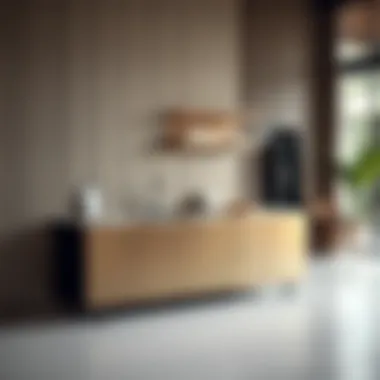
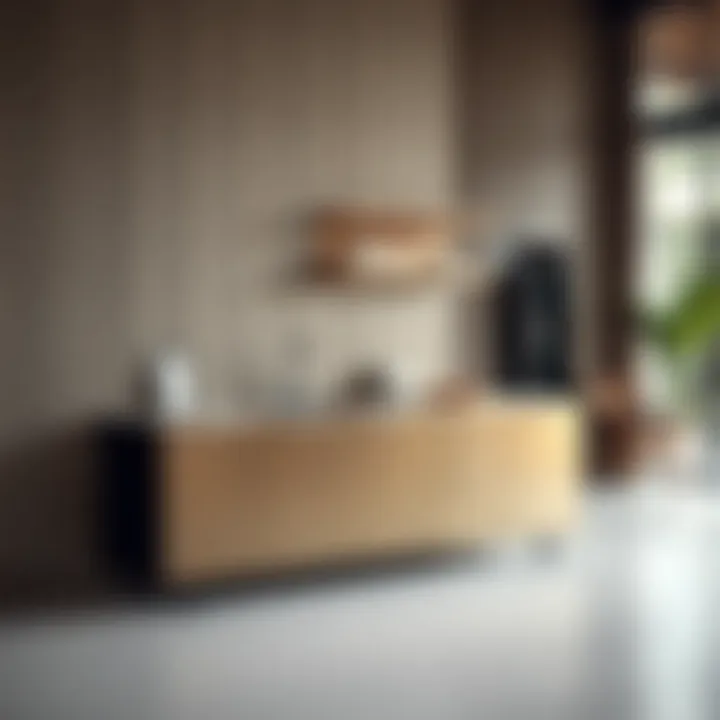
Intro
Thin metal cabinets have carved a niche in the realm of furniture design, intertwining style and practicality in a unique manner. Their adoption in modern interiors is not just about aesthetics, but a reflection of changing preferences driven by functionality and versatility. From sleek urban apartments to rustic homes, these cabinets adapt seamlessly, offering both elegance and utility.
The appeal of thin metal cabinets lies in their minimalist design, allowing them to blend effortlessly into diverse settings. Their presence can be subtle yet impactful, contributing to the overall vibe of a room without overwhelming it. In this discussion, we aim to delve into the various dimensions of thin metal cabinets—from materials and trends to selection tips—highlighting their significance in contemporary design.
As we navigate through the nuances of this topic, readers positioned as homeowners, designers, or decorators will find insights that illuminate the ways thin metal cabinets can enhance living spaces, making them both functional and stylish.
Furniture Design Trends
Trending Materials and Textures
Metal has always been a favorite in interior design due to its durability and sleek finish. Recent trends have seen a shift towards lighter metals, such as aluminum and powder-coated finishes. These materials not only reduce the weight of cabinets but also lend a modern touch that resonates well with contemporary themes. A satin finish, for instance, adds a soft sheen that contrasts beautifully with sharper lines, creating an inviting atmosphere.
Additionally, incorporating textures can be a game changer. For example, a slight perforation can introduce depth, making a cabinet not just a storage solution but a focal point. Mixing materials like wood with metal elements also enhances the tactile experience, which is increasingly valued in physical spaces.
"Metal cabinets today are more than just utilitarian objects; they are integral pieces of art that can shape the mood and functionality of a space."
Color Palettes and Styles
The color spectrum for thin metal cabinets has expanded beyond traditional silvers and blacks. Designers now embrace bold hues like deep greens, navy blues, and even shades of rust, which can breathe life into an otherwise neutral room. When you juxtapose these colors against bright walls or natural wood, the effect can be striking.
Styles vary widely—from industrial aesthetics with raw finishes to modern Scandinavian designs that prioritize simplicity and fluidity. Each style presents opportunities to play with layouts and placements in living areas, enhancing functionality while maintaining an eye-catching appearance.
Incorporating these colorful and stylistic choices can transform any room. Think about how a vivid red cabinet can create an accent in a muted dining area, or how a minimalist gray piece could serve as an understated complement in a busy home office.
Practical Tips for Furniture Selection
Assessing Space and Functionality
Before investing in thin metal cabinets, assessing available space is crucial. Measure your area thoughtfully to ensure that the cabinet not only fits but complements the existing setup. Consider the height, width, and depth of the cabinets in relation to furniture and wall space.
Understanding how the cabinet will be used also shapes the selection process. Are you looking for a stylish way to store books, or do you need a sleek solution for kitchen essentials? The multidimensional nature of thin metal cabinets means they can serve various roles, making functionality a top priority.
Balancing Aesthetics with Comfort
Designing spaces with thin metal cabinets requires a balance between style and comfort. These cabinets should enhance the experience of the environment, not detract from it. Consider the flow of movement within the space; a well-placed cabinet can enhance functionality while adding to the aesthetic appeal.
It may seem daunting to find harmony between the hard edges of metal and soft furnishings, but it’s possible. Pair a sleek cabinet with plush seating or incorporate greenery nearby to soften the industrial feel. This balance creates a welcoming atmosphere without compromising on modern design principles.
By weaving together the trends and practical considerations surrounding thin metal cabinets, homeowners and decorators alike can appreciate their transformative potential in contemporary spaces. Whether for utility or style, these cabinets stand as testament to evolving design frontiers.
Intro to Thin Metal Cabinets
Thin metal cabinets have emerged as a stylish and functional addition to modern interiors. They offer a unique blend of aesthetics and practicality, making them an appealing choice for homeowners, designers, and decorators alike. The importance of these cabinets lies not just in their sleek appearance, but also in how they can transform a space, adding both beauty and efficiency.
When considering interior design, the role of storage solutions often takes a backseat. However, thin metal cabinets challenge this notion by serving as both functional elements and key design features. Their streamlined contours and varied finishes allow them to fit into various styles, from industrial chic to minimalism. This versatility is essential in today’s diverse home environments.
As we explore this topic, it’s crucial to recognize the benefits these cabinets bring:
- Optimized Space Utilization: Their design typically requires less physical space while offering ample storage.
- Enhanced Durability: Made from robust materials, they withstand wear and tear better than some traditional options.
- Aesthetic Appeal: With a wealth of styles and finishes, thin metal cabinets can enhance or contrast with existing décor, elevating the overall look of any room.
Moreover, their historical significance sets the stage for understanding contemporary designs. Thin metal cabinets have evolved over decades, adapting to changes in consumer preferences and technological advancements. This historical context not only informs us of their current place in interior design but also highlights their journey through various design movements.
In summary, thin metal cabinets aren't just simple storage solutions; they are pivotal in modernizing spaces and enhancing functional living. This article will delve deeper into their defining traits, historical significance, and their impactful presence in today's design landscape.
Material Characteristics
The material characteristics of thin metal cabinets play a pivotal role in their design, functionality, and overall value within living and working spaces. Understanding these qualities helps homeowners, designers, and decorators make informed decisions when selecting cabinets that align with their specific needs and aesthetic preferences. The choice of materials profoundly influences durability, maintenance, and even the visual appeal of these versatile furniture pieces.
Types of Metal Used
Thin metal cabinets are typically crafted from a range of metals, each contributing unique properties to the final product. Commonly used metals include:
- Steel: This robust material remains a favorite for cabinets because of its strength and resistance to dents. Galvanized steel, which has added protection against rust, is especially popular in kitchens and bathrooms.
- Aluminum: Often seen as a lighter alternative to steel, aluminum is celebrated for its resistance to corrosion and ease of manipulation. It lends itself well to sleek, minimalist designs and is often used in contemporary spaces.
- Stainless Steel: This is another strong contender, especially in commercial environments. Its shiny finish and non-reactive surfaces make it ideal for food and laboratory settings, while also adding a touch of modern elegance to any room.
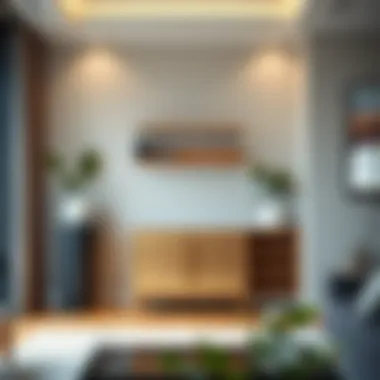
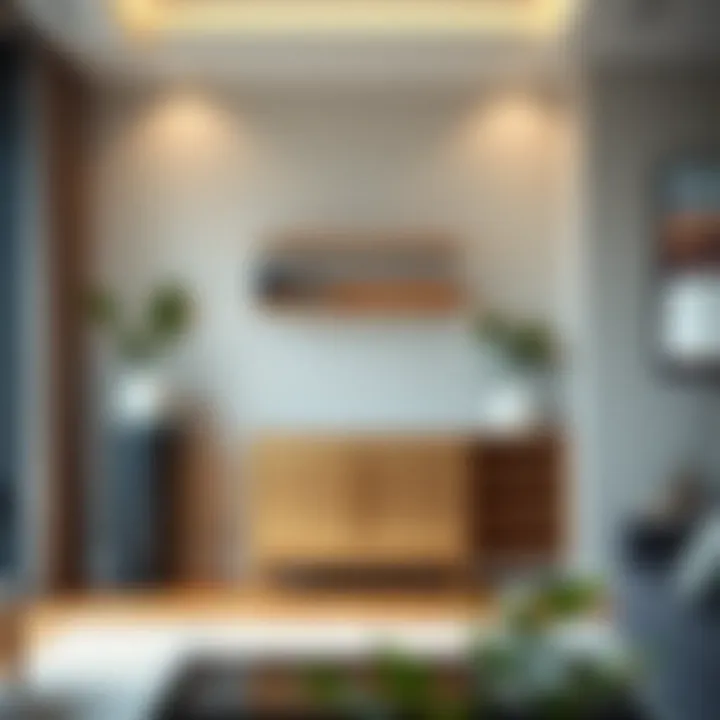
By selecting the right type of metal, one can enhance not just the visual appeal but also the functional longevity of the cabinets.
Durability and Longevity
Durability in thin metal cabinets is non-negotiable, especially in high-traffic areas. These cabinets, when made from quality materials, are designed to withstand daily wear and tear, making them an excellent investment for both home and commercial use. Factors that contribute to durability include:
- Material Thickness: Thinner metal may be more prone to bending and damage; thus, cabinets that use a heavier gauge material tend to last longer.
- Finish Quality: Powder coating and electroplating can significantly improve resistance to scratches, rust, and the everyday bumps that come with use. A high-quality finish not only protects the cabinet but also enhances its visual charm.
Investing in durable thin metal cabinets means fewer replacements and repairs down the line, making them a smart choice for budget-conscious individuals.
Weight Considerations
When it comes to weight, thin metal cabinets strike a fascinating balance. Unlike bulky wooden counterparts, these cabinets typically maintain a lighter profile, which can be a distinct advantage in a few ways:
- Ease of Installation: Lighter materials make for straightforward installation, whether it's a DIY project or a job for professionals. This can reduce labor costs and time.
- Flexibility: Lighter cabinets allow for more flexibility in arrangement and repositioning within spaces, accommodating changes in personal taste or design trends over time.
- Structural Impact: A lighter cabinet can reduce stress on walls, especially important in older structures where weight-bearing considerations are paramount.
Design Aesthetics
Design aesthetics play a crucial role in how thin metal cabinets complement various interiors, serving not merely as storage solutions but also as statements of style. When considering these cabinets, homeowners and designers alike should look beyond functionality to embrace how visual elements harmonize with surrounding decor. The sleek lines and minimalist profiles of thin metal cabinets allow them to blend with a variety of styles, from industrial to modern chic, emphasizing their versatility in diverse settings.
Styles and Finishes
When it comes to styles and finishes, thin metal cabinets offer a spectrum that caters to individual tastes and preferences. For instance, a matte black finish can inject a contemporary elegance into a space, while a brushed stainless steel effect exudes a more utilitarian vibe. Each finish communicates something different about the cabinet's role in an environment.
- Matte Finishes: These bring an understated sophistication that reduces glare and adds depth. They can serve as a backdrop for colorful decor items or artwork.
- Glossy Finishes: A high gloss shines bright and can make a confined space feel larger, reflecting light and brightening the area.
- Textured Finishes: Options like powder coating or embossed patterns add tactile interest, which can enhance the way light interacts with the surface.
Furthermore, some cabinets adopt eclectic styles—imagine combining wood grain trim with metal frames—striking a balance that captures attention without overwhelming the senses. Ultimately, choosing the right finish is integral to ensuring that the cabinet not only serves its purpose but also enhances the overall aesthetic of the room.
Color Options
Color opens a realm of possibilities when selecting thin metal cabinets. It’s where aesthetic choice meets personality. The color scheme you choose can reflect sentiments, moods, and themes that resonate throughout your space. Some popular considerations include:
- Neutrals: Whites, grays, and blacks provide timeless appeal, fostering a calming atmosphere. This palette works particularly well in spaces aiming for a serene ambiance.
- Bold Colors: Reds, blues, and greens can become focal points, drawing the eye and adding vibrancy. Perfect for those who seek to make a statement.
- Pastel Shades: Soft pastels can conjure a sense of warmth and cosiness, making them suitable for relaxed environments like family rooms or nurseries.
Choosing a color should align with the broader color scheme established in the room, creating a sense of cohesion. Additionally, it’s worth noting that colors evoke different emotions. Choosing the right hue can enhance productivity in a home office or bring comfort to a living space.
Remember: The color and finish of a cabinet can fundamentally alter the perception of the space. Pick wisely to create an environment that feels just right.
Functional Advantages
Thin metal cabinets offer a range of practical benefits that enhance both residential and commercial environments. Their importance cannot be understated — they combine aesthetic appeal with utility, making them ideal for various settings. The following sections dive deeper into two key advantages: space-saving benefits and organizational features.
Space-Saving Benefits
In today’s world, where real estate is often at a premium, the ability to maximize space is crucial. Thin metal cabinets are designed to occupy less volume while providing ample storage solutions. They can be neatly tucked into corners or flat against walls, which is a game-changer for smaller spaces like apartments or compact offices.
- Compact Design: The slender profiles of these cabinets allow for greater flexibility in layouts. Homeowners can also use them in unconventional places, such as hallways or nook areas that would otherwise go unused.
- Layered Storage Options: Many of these cabinets come with adjustable shelves, enabling you to customize the interior to fit varied items. This adaptability is essential for ensuring that every inch of space counts.
By integrating thin metal cabinets into your home or workspace, not only are you saving valuable square footage, but you’re also paving the way for a more fluid movement between spaces, making areas feel less cluttered.
Organizational Features
Good organization is the backbone of functionality in any cabinet system. Thin metal cabinets incorporate several features that promote tidiness and efficient use of space.
- Dividable Sections: Many models boast removable dividers that create multiple compartments. This allows users to store a variety of items, from files to kitchenware, without having them intermixed.
- Locking Mechanisms: For commercial or shared environments, security can be a real concern. Thin metal cabinets often contain built-in locks, making it easier to keep sensitive materials or valuable items secure.
- Open and Closed Storage: These cabinets typically offer a mix of open shelving and closed compartments. This design allows for displaying decorative items on shelves while concealing clutter behind doors, appealing to both organizational needs and aesthetic desires.
"The right storage solution doesn’t just save space; it transforms how a room functions and feels."
Additionally, thoughtful features such as cable management systems in office-grade cabinets simplify the often-awkward task of organizing electronics. Overall, the blend of innovative designs and practical features in thin metal cabinets significantly enhances their functionality, making them a worthy consideration for any design-centric homeowner or professional.
For further insights and tips on maximizing the use of space through effective storage solutions, you may find these resources useful: Wikipedia on Storage Solutions and Britannica on Modern Furniture.
Versatility in Applications
The versatility of thin metal cabinets cannot be overstated. They present a unique blend of style, durability, and function across various environments. In many ways, their adaptability is what sets them apart from traditional cabinetry. While often associated with modern aesthetics, the uses of these cabinets stretch far beyond mere visual appeal. They respond to diverse needs, from optimizing small spaces in urban homes to providing efficient storage solutions in bustling commercial settings. Let's delve into what makes these cabinets such a valuable addition to both residential and commercial contexts.
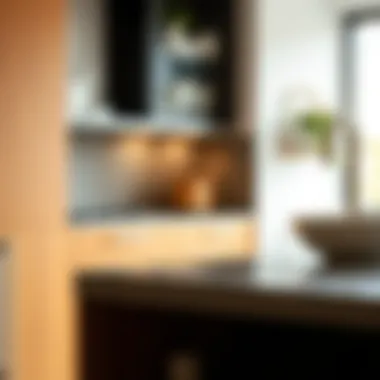
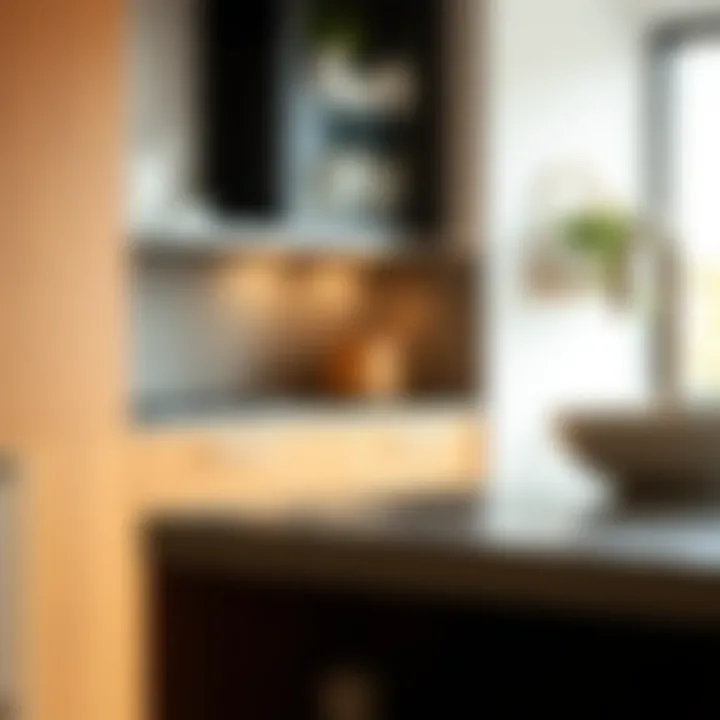
Residential Uses
In residential spaces, thin metal cabinets shine like diamonds in the rough. Homeowners often seek innovative ways to maximize utility without sacrificing style, and these cabinets fit the bill. Consider a compact apartment that is heavy on charm but lacks storage. A sleek, metallic cabinet can offer a striking focal point while housing everything from kitchen essentials to living room knick-knacks.
- Creativity in Design: With their clean lines and bold finishes, thin metal cabinets can complement various interior designs, from minimalist to industrial chic.
- Functionality: In a cozy kitchen, for instance, a thin metal cabinet can serve as a versatile pantry, making the most of limited space without overcrowding.
- Flexibility: They can be used in laundry rooms, bedrooms, or even as unique nightstands.
Imagine a space where a carefully positioned metal cabinet organizes craft supplies in a family area, making it both functional and seamless with the home decor. Whether it’s a vintage piece or a sleek, contemporary design, finding a cabinet that fits the style of an individual home is a smooth process.
Commercial Spaces
When it comes to commercial usage, thin metal cabinets bring a whole new set of benefits. Businesses require storage solutions that are not just practical but also contribute to the overall ambiance of the environment.
- Professional Appearance: For restaurants, sleek metal cabinets can house dishes and utensils, ensuring that the workspace is tidy and visually appealing for customers, not to mention efficient for employees.
- Durability: These cabinets withstand heavy use, making them ideal for retail environments where they can serve various purposes, from displaying merchandise to securely storing inventory.
- Space Efficiency: In an office setting, thin metal cabinets can help in organizing files and supplies without taking up valuable floor space, essential in bustling workplaces.
Think of a trendy café incorporating thin metal cabinetry that houses both storage for ingredients and a stylish display of curated items for sale. This demonstrates that functionality and design can seamlessly coalesce in commercial spaces, providing added value to both the business and its patrons.
In various environments, thin metal cabinets showcase their versatility, merging aesthetic appeal and practicality effortlessly.
In summary, the application of thin metal cabinets in both residential and commercial spaces underscores their importance. They not only enhance organization but also elevate the character of the environments they inhabit. As we've discussed, thin metal cabinets offer unique solutions tailored to diverse needs, making them an integral element in contemporary design.
Incorporating Thin Metal Cabinets into Your Space
In recent times, thin metal cabinets have emerged as a functional and aesthetic choice for many living environments. These cabinets not only serve practical purposes but also add a distinctive flair to the overall decor of a space. Understanding how to incorporate them effectively can transform your home or workplace, enhancing both organization and style.
Complementing Existing Decor
The beauty of thin metal cabinets lies in their versatility. With various finishes and designs, they can seamlessly blend into almost any existing decor. Whether your style leans towards industrial chic or modern minimalism, there’s likely a thin metal cabinet that will complement your surroundings. The sleek lines and subtle elegance of these cabinets can act as a counterbalance to bulkier furnishings.
For instance, if you have wooden elements in your room, choosing a cabinet with a brushed steel finish can create an interesting contrast while maintaining a harmonious feel. The key is to look not just at color but also at texture and scale. A well-chosen cabinet can enhance the visual story of a room without overwhelming it.
- Consider the overall theme: Is your decor more rustic or contemporary?
- Pay attention to color palettes: Neutral tones often work well with metal finishes.
Creating Cohesive Design
To create a cohesive design within your space, think about how thin metal cabinets relate to other elements within the environment. It’s essential to ensure that every piece within a room tells a part of the same story. You can achieve this through the strategic use of color, materials, and design aesthetics.
One way to ensure cohesiveness is by repeating materials and colors in various elements throughout the space. For example, if your cabinets are a dark matte finish, consider adding small decorative pieces or artwork with similar hues. This strategy not only ties the room together but also elevates the cabinet from a mere storage solution to a standout feature.
Furthermore, lighting plays a critical role in how thin metal cabinets are perceived. Soft ambient lighting can enhance the smooth surface, making the metal appear more inviting. If possible, position the cabinets in a way that takes advantage of natural light, allowing them to reflect and diffuse illumination around the room effectively.
"A thoughtfully designed space can evoke emotions and inspire its occupants; thin metal cabinets can play a vital role in this narrative."
To sum up, thin metal cabinets can significantly influence the aesthetics of a room. By complementing existing decor and weaving together a cohesive narrative with other design elements, these cabinets become an integral part of creating a beautifully curated space.
Maintenance and Care
Maintaining thin metal cabinets is not just a chore; it’s a vital part of ensuring their longevity and aesthetic appeal in your space. Given that these cabinets serve as functional pieces of furniture, their upkeep can significantly impact both their performance and appearance. Regular maintenance helps maintain their pristine look and can prevent wear and tear that might arise from daily use. Caring for these cabinets means understanding their material properties and appropriate cleaning methods.
Cleaning Techniques
Keeping thin metal cabinets clean doesn’t have to be a daunting task. Here are some effective techniques that work wonders:
- Microfiber Cloths: Using soft, lint-free microfiber cloths can help remove dust and smudges without scratching the surface. It’s like having a little cleaning superhero in your toolkit!
- Gentle Cleaners: Avoid using harsh chemicals that could damage the finish. Instead, opt for mild dish soap mixed with water. Just a few drops go a long way—dip your cloth in the solution, wring it out, and wipe down the cabinets.
- Baking Soda Paste: For tougher stains, a paste made from baking soda and water can be incredibly effective. Apply it to the stain, let it sit for a few minutes, then gently scrub with a soft cloth. It’s a simple yet efficient method that’s safe for metal surfaces.
- Regular Dusting: Setting a schedule for regular dusting can help maintain the appearance of the cabinets. Aim for a quick dusting once a week and a more thorough clean once a month. Regular maintenance prevents dirt build-up and keeps cabinets looking fresh.
The goal here is to keep your cabinets looking as good as new without much fuss.
Preventing Rust and Corrosion
When it comes to thin metal cabinets, rust and corrosion can be the enemy. Implementing proactive measures can significantly reduce the risk:
- Proper Ventilation: Ensure that the area where your cabinets are placed is well-ventilated. Keeping moisture at bay is crucial, as humidity can accelerate corrosion.
- Protective Coatings: Many manufacturers coat their cabinets in a protective layer. However, over time, this can wear away. Consider applying a wax or polish specifically designed for metal surfaces to create an extra barrier.
- Addressing Scratches Promptly: If you notice any scratches or chips in the finish, addressing them right away is important. Use touch-up paint that matches the cabinet's color to fill in the damage. This quick fix prevents moisture from getting underneath the surface.
- Use of Silica Gel Packs: Placing silica gel packets inside your cabinets can help absorb moisture in closed environments. While they are often used for shoe boxes and other containers, don’t underestimate their use in metal cabinets.
Preventing rust isn’t just about keeping things looking good; it’s about ensuring your investment lasts for years to come.
By adopting these maintenance and care practices, you’re not only ensuring the functionality of your thin metal cabinets but also preserving their design integrity. The time and effort invested in regular cleaning and preventive measures will pay off, contributing to a stylish and functional environment that stands the test of time.
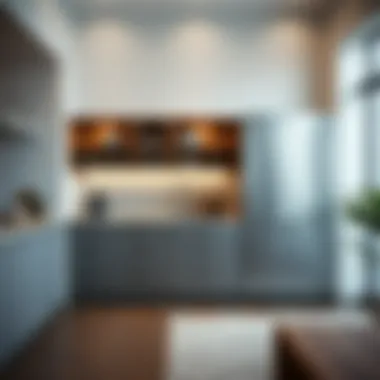
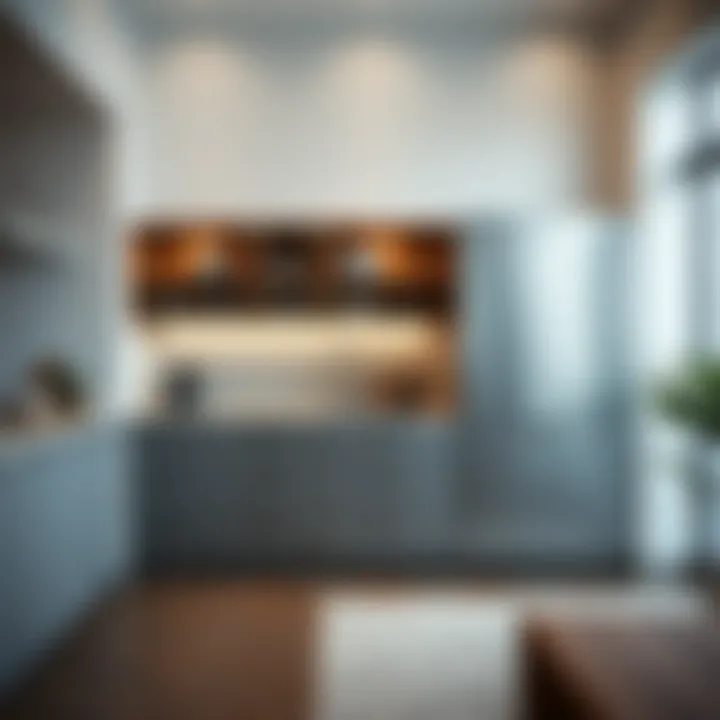
Cost Considerations
When pondering over thin metal cabinets, it’s natural to weigh the costs against their manifold advantages. Understanding cost considerations is vital for homeowners, designers, and decorators alike. It elucidates how investment in these cabinets translates to both tangible and intangible benefits, making it crucial to recognize not just the price tag but the overall value these cabinets add to a space.
Price Range Overview
Thin metal cabinets come in a diverse array of price points. The pricing can vary extensively due to several factors including materials, finishes, size, and brand reputation. Here’s a rundown of what you might expect:
- Budget-friendly options: Entry-level models typically range from $100 to $300. These are often basic in design and finish, but can still serve functional purposes, especially in utility spaces or garages.
- Mid-range selections: Priced between $300 and $700, these cabinets often feature better quality materials and finishes, introducing more design elements and sturdiness.
- High-end choices: For $700 and above, you will find cabinets that are not only aesthetically pleasing but also highly durable. These often include custom designs, intricate finishes, or are made from premium metals like stainless steel.
Given the varying price ranges, it’s essential to define what aligns best with your needs and budget before making a decision.
Cost vs. Value Analysis
Evaluating cost against value when considering thin metal cabinets is a critical step. It’s not merely about the amount spent but rather the return on investment these cabinets can yield. Here are a few points to consider:
- Durability: Thin metal cabinets often outlast wood counterparts, resisting warping and wear due to moisture and time. Investing more initially can mean fewer replacements over the years.
- Versatility: Their functional adaptability means they can fit in various spaces, from kitchens to offices and garages. This multi-functionality can often negate the need for purchasing multiple storage solutions.
- Aesthetic Appeal: High-quality finishes enhance the overall look of your space, which can increase property value—not to mention the satisfaction of owning a stylish piece of furniture.
"The best investment can often be what you don’t need to replace time and again. Thin metal cabinets shine in this aspect."
Ultimately, while you may pay a higher initial cost for premium thin metal cabinets, the longevity, function, and beauty they bring can make them worth the splurge.
Future Trends in Thin Metal Cabinets
The exploration of thin metal cabinets takes us beyond traditional understandings of design and utility. As we look forward, we are poised to witness significant transformations that will reshape how these cabinets are utilized in various settings. This section discusses the anticipated future trends in thin metal cabinets, emphasizing the innovations in design and the growing emphasis on sustainability. These elements not only inform consumers but also guide designers and manufacturers in aligning with contemporary values and practical needs.
Innovations in Design
In the realm of thin metal cabinets, innovation about design is on the up. Manufacturers are increasingly experimenting with new forms, aesthetics, and technological integration. For example, look at how modularity has become a focal point. The concept of interchangeable parts and customizable modules allows homeowners to create unique configurations tailored to their specific spaces.
Moreover, we can expect an infusion of smart technology in these cabinets. Technologies like integrated lighting or sensors that detect humidity and temperature are appearing. This advancement not only adds practicality but also elevates the user experience, bridging the gap between functionality and modern living demands. Consider how the rise of home automation devices is integrating with furniture design, creating paired functionalities.
Other fresh trends involve exploration of various finishes and textures—whether it’s a matte, brushed, or glossy surface, the choice significantly influences the cabinet's overall appeal. With a rise in urbanization, designs adopting an industrial chic vibe might gain traction, merging rugged simplicity with refined detail.
"Innovative design not only reflects current trends but also anticipates future needs and aspirations."
Additionally, the move towards minimalism and clean lines influences how designers approach cabinet aesthetics. Providing visual continuity with an uncluttered feel aligns with the desires for simpler living in our increasingly hectic lives.
Sustainability in Materials
As society becomes more environmentally conscious, the focus on sustainability in materials is more crucial. The materials used in thin metal cabinets are no exception.
For starters, recycled metals are gaining popularity. Not merely a trend, this movement signifies a commitment to reducing waste and utilizing available resources efficiently. Manufacturers sourcing recycled aluminum or steel not only lower their carbon footprint but also appeal to a modern audience that prioritizes responsible sourcing.
Beyond materials, the production processes are also evolving. Innovative methods such as advanced manufacturing technologies are set to reduce energy consumption during the shaping and assembling of thin metal cabinets. Additionally, finishes that are eco-friendly or low in volatile organic compounds (VOCs) are emerging, providing healthier options for indoor environments.
It’s also important to highlight the longevity of thin metal cabinets. Their durability means less frequent replacements and less waste over time, which complements the shift towards sustainable living. Consumers are becoming increasingly aware that investing in quality, environmentally friendly products adds to their value in the long run.
In summary, the future of thin metal cabinets is tied to innovative designs that embrace technology and aesthetics while engaging with sustainable practices. Both elements are poised to shape the cabinets' functionality and appeal in homes and commercial spaces.
Culmination
The significance of thin metal cabinets in modern interiors cannot be overstated. They serve not only as functional storage solutions but also as key components of design that can dramatically enhance the aesthetic appeal of any space. This article has dissected their multifaceted benefits, from material characteristics and design aesthetics to versatility in various applications. Each of these elements contributes uniquely to how these cabinets fit into contemporary life and style.
Summative Insights
In summary, thin metal cabinets offer a blend of durability, minimalism, and style that resonates well in today’s decor. Their robust construction means they withstand the test of time, while the variety of finishes available can complement just about any design motif. Homeowners can find options that encourage innovation in space usage, whether it’s a sleek kitchen, a tidy office, or a stylish living room. The cabinets' slim profiles make them perfect for smaller spaces, helping to keep clutter at bay without compromising usability or aesthetic.
Here are some key points that we have covered in this article:
- Material Choices: Different types of metal and their unique properties make a difference in both durability and appearance.
- Design Aesthetics: Contemporary finishes and styles allow for customization to fit any decor.
- Versatility in Use: These cabinets are as suitable for residential areas as they are for commercial spaces, showing their adaptability.
- Maintenance: Proper care helps in keeping these cabinets looking fresh and new, extending their lifespan.
Final Thoughts on Integration
Integrating thin metal cabinets into one’s living or working space requires thoughtful deliberation. Consider how they align with the overall design vision of the area. Is there a balance between form and function? Moreover, think about practical aspects such as how often you will access the contents of the cabinet. The beauty of these cabinets lies in their ability to be seamlessly merged with both modern and traditional interiors.
Homeowners and designers alike should take a moment to explore not just the aesthetic benefits but also the functional sophistication that thin metal cabinets bring. Whether standing alone or working in concert with other furniture and decor elements, their integration can lead to a more organized and visually appealing environment. This makes them an invaluable addition in the realm of modern furnishings.
For further exploration on this topic, you might refer to resources like Wikipedia, Britannica, or specialized forums on Reddit.
"Metal cabinetry is no longer just a utilitarian necessity; it's a stylish statement in modern design."



